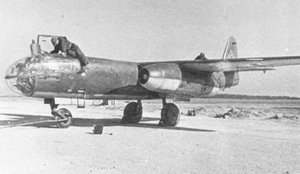Arado Ar 234
|
|
The Arado Ar 234 Blitz was the world's first operational jet powered bomber, built by the Arado company in the closing stages of World War II. In the field it was used almost entirely in the reconnaissance role, but in its few uses as a bomber it proved to be impossible to intercept.
| Contents |
Background and prototypes
In early 1941 the RLM offered a tender for a jet powered high-speed reconnaissance aircraft with a range of 2150 km (1,340 miles). Arado was the only company to respond, offering their E.370 project. This was a high-winged conventional-looking design with a Junkers Jumo 004 engine under each wing.
Arado estimated a maximum speed of 780 km/h (485 mph), an operating altitude of almost 11,000 m (36,000 ft), and a range of 2,000 km (1,250 miles). The range requirement was very difficult to meet, so to reduce weight the plane would take off on a wheeled trolley, and land on skids at the end of the flight.
The range was still a little less than what the RLM wanted, but they liked the design and ordered two prototypes as the Ar 234. The first two prototypes were largely complete before the end of 1941. However the Jumo 004 engines weren't ready, and wouldn't be ready until February 1943. When they did arrive they were only cleared for static and taxi tests, considered too unreliable by Junkers to be used for in-flight use. Flight-qualified engines were finally delivered that spring, and the Ar 234A-0 made its first flight on July 30th, 1943. By September four prototypes were flying.
Ar 234B
The RLM had already seen the promise of the design and in July had asked Arado to supply two prototypes of a Schnellbomber version as the Ar 234B. Since the aircraft was very slender and entirely filled with fuel tanks, there was no room for a bomb bay and the warload had to be carried on external racks. The added weight and drag reduced the speed to "catchable" so a set of 20 mm guns was added to a tail stinger for defence. Since the pilot had no view to the rear they had to be aimed through a periscope. The system was generally considered useless and many pilots had the guns removed.
The external bomb load made the skid-landing system impractical, so the bomber version was modified to have tricycle landing gear. The ninth prototype was the first Ar 234B, and flew in March 1944. The B models were slightly wider to hold the landing gear, and with added bomb load the plane would fly as slow as 660 km/h (410 mph). This was still better than any bomber the Luftwaffe had at the time, and made it the only bomber with any hope of surviving the massive allied air forces.
Production lines were already being set up, and twenty B-0 pre-production planes were delivered by the end of June. Later production was slow however, as the Arado plants were tasked with producing planes from other bombed-out factories hit during the Big Week. Meanwhile several of the A models were sent forward in the reconnaissance role. There they proved to be basically invulnerable. In most cases it appears they were never even detected, cruising around 460 mph (740 km/h) at over 30,000 ft (9,100 m).
The few B's entered service in the fall and impressed their pilots. They were fairly fast and completely aerobatic. The long takeoff runs led to several accidents; a search for a solution lead to improved training as well as the use of RATO, or rocket assisted takeoff. The engines were always the real problem; they suffered constant flameouts and required overhaul or replacement after about ten hours of operation.
Most of the B's were built as bombers, but the few recce versions of the B model flew more missions. Like all jet engines, the fuel consumption of the Jumos varied widely with altitude; at 10,000 m it was a third of what it was at sea level. This meant that for low-altitude bombing missions the operational radius of the aircraft was only about 190 km (120 miles), while for high-altitude reconnaissance the range was as much as 720 km (450 miles) with drop tanks.
The only notable use of the plane in the bomber role was their use in the attempt to destroy the Ludendorf Bridge at Remagen. The aircraft continued to fight in a scattered fashion until Germany surrendered on May 8th, 1945. Some were shot down in air combat, destroyed by flak (sometimes their own), or bounced(?) by Allied fighters when they came in to land. Most simply sat on the airfields waiting for fuel which never arrived.
Ar234-C3.jpg
Ar 234C
Version of the world's first jet bomber equipped with four BMW 003A engines to free up Junkers Jumo 004s from use by Me 262. Improved overall thrust. A fine aircraft but not numerous enough to affect the outcome of the war. Only 15 of them were built.
See also
External links
- Air Vectors - Arado Ar 234 (http://www.vectorsite.net/avar234.html)
|
Lists of Aircraft | Aircraft manufacturers | Aircraft engines | Aircraft engine manufacturers Airports | Airlines | Air forces | Aircraft weapons | Missiles | Timeline of aviation |

